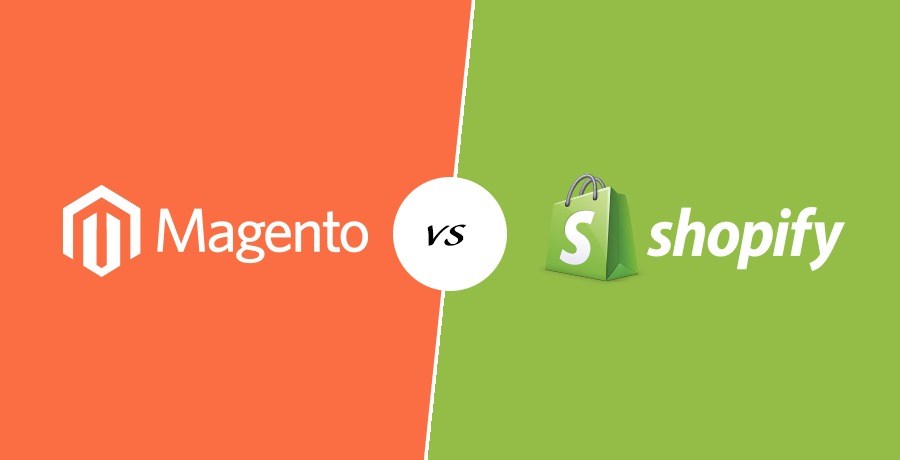Any online store requires a solid ecommerce platform to remain functioning and engaging for the customers. The shopping experience clearly makes an online store popular and an ecommerce CMS platform has a big role to play in it. Both Magento and Shopify are two of the most popular ecommerce platforms used for development by software development companies in India and across the globe. In such a case, by comparing these two platforms we can reveal many merits and demerits of the two platforms for the benefit of the aspiring ecommerce businesses and online stores.
Elementary Differences between Magento and Shopify
Let’s start with the basic and most elementary differences between the two platforms.
Ease of setting up
With Shopify setting up your store and start selling is practically is a matter of few minutes while with Magento you need some developers to build the store and make your online business live.
Inventory management
The Shopify Starter plan costing only $14/mo just allows you to sell only 25 items through the store while the Magento community edition which is free allows you to sell an unlimited number of products. On the sly side, in spite of allowing unlimited product range Magento can have performance issues, especially concerning the loading speed of the product pages. In contrast, Shopify being fully managed solution will always deliver smooth and fast-paced performance.
Shipping charges
Both the platforms are equipped to calculate shipping charges in real time when selling physical products through the online stores.
Promotional coupons and discount
With Magento, you can easily roll out promotional campaigns and boost user traction through coupons and discount codes. With Shopify starter plan you do not have any option regarding this except taking help from add-ons. But with advanced Shopify plans you can avail such features.
Payment gateway
Shopify supports a whopping 70 different types of payment gateways. In comparison, the supported gateways are significantly lower in number with Magento. Though Magento always allows adding more payment gateways through third-party add-ons.
Themes and Templates
Although both Shopify and Magento offer a very large number of themes and templates to give your ecommerce store the desired look and feel, the number of free themes is much lower with Shopify compared to that of Magento. While both offer premium themes, the price of a premium Shopify theme starts at $80 compared to that of Magento themes starting just at $1.
Third party add-ons
When it comes to expanding the functions and features of an ecommerce store, third-party add-ons play an important role. While Shopify offers more than 100 different add-ons and apps for adding extra features and functions, Magento’s range of third-party apps and add-ons is pretty large consisting more than 5000+ such apps and add-on.
Multilingual capabilities
Shopify is not fully multilingual as a platform and you need addons for the multilingual appearance of your ecommerce store. In contrast, Magento has robust in-built multilingual support.
SEO readiness
Inbuilt SEO capabilities are important to drive organic traffic to the stores. In this respect, both Shopify and Magento have a host of powerful SEO friendly features and capabilities.
Customization
Both platforms allow a lot of customisation options while creating the store. Both allow tweaking the directly HTML/CSS code to come with your preferred custom look and feel of the store. Shopify offering a menu oriented method allows choosing different aspects of your store including font, colour, etc. Magento, on the other hand, offers extensive customisation options by offering all its code as open-source. The only difference is, to incorporate the full potential of Magento’s customisation you need a deeper knowledge of the platform and HTML/CSS coding.
Blogging function
Shopify offers easy and integrated blogging function while with Magento you need to achieve this by using a free plugin.
Popularity
When it comes to popularity, Magento is ahead of most other platforms with 14% of the top million websites built with Magento. In comparison, Shopify is used by only 6% of the top one million websites. While Magento is preferred by a large number of global business giants, Shopify is mostly preferred by small and medium enterprises.
The programming language
When it comes to the coding language, Magento uses PHP, while Shopify uses Liquid. While Magento allows altering the template code as per your customisation needs, Shopify doesn’t allow tweaking the code base. This is why Shopify suits simple web stores while Magento is mostly suited for complex web stores requiring deeper custom attributes.
Cost
Magento is free of cost CMS platform allowing anybody to use it for creating a storefront. But it doesn’t provide hosting service and so you need to pay for a hosting service. In comparison, Shopify comes as a software-as-a-service (SAAS) equipped with a hosting solution. After the free trial period is over you need to pay a monthly subscription fee for any of the Shopify plans you choose that varies between $29/month to $179/month.
Scalability
There is not much difference in this regard. With Shopify, you can gradually grow and as it fits suitable can opt for higher plans. With Magento, you stay scalable all the way from the first day to the later days when your store gets large traffic.
Performance and speed
Shopify is built to load faster and as it comes with hosting service, the performance and loading speed are well taken care of. Magento in this regard was slightly depressing but with the release of much faster Magento 2 such concerns are now finally addressed.
Checkout
When it comes to user-friendly and quicker checkout process, Magento 2 looks slightly ahead of Shopify. Both the platforms allow users getting through the process pretty quickly.
Community
Compared to Shopify Magento has a robust global community of developers and offers access to a large range of solutions to diverse user needs. Shopify, on the other hand, being a service-oriented software mostly depends upon customer service for solutions to issues.
Conclusion
To conclude, there can be no straightforward judgment regarding the choice of an ecommerce platform. It depends on your budget, growth prospect, kind of store you want to create, the product range, your audience and several other factors. Both the platforms have their respective strengths and weaknesses, but you need to make a choice between them.
Author Bio: Aditya Khanna
Content marketer and marketing technologist by profession, Aditya is passionate about digital marketing and technology. He likes sharing his knowledge on software development and digital marketing. He is associated with Justgoweb Digital and Imenso Software as a digital marketing consultant.






